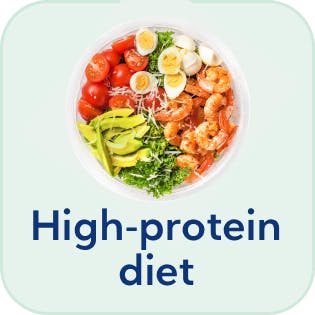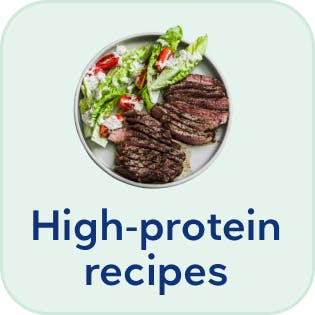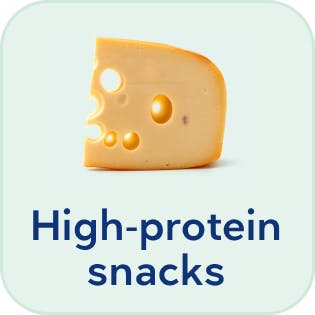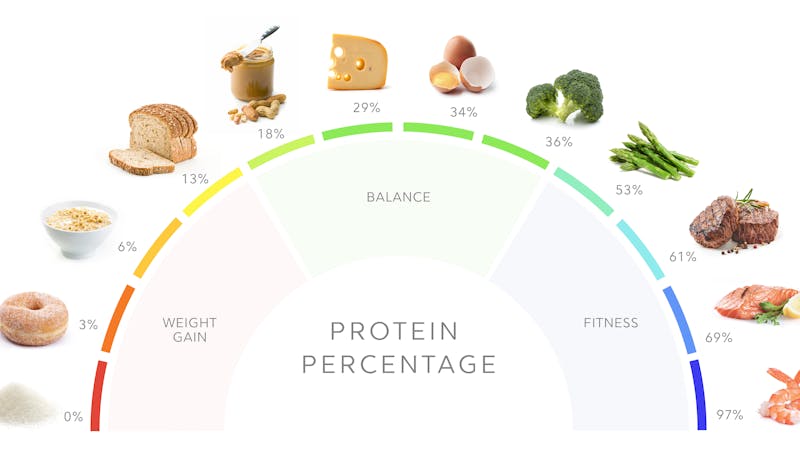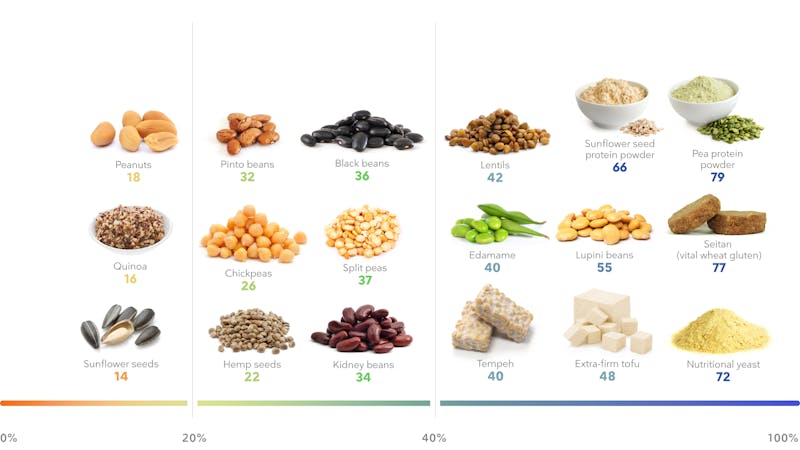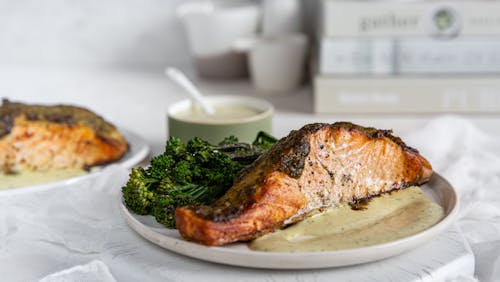How and why to eat more protein
Are you wondering if you should eat more protein on your keto or low-carb diet?
This guide will help you understand my experience with the benefits of ensuring adequate protein and give you practical tips for how and when to increase protein.
I’m Dr. Ted Naiman, I’m a family physician, and I’m the author of The P:E Diet (i.e. protein-to-energy ratio diet), which I co-wrote with William Shewfelt in 2019.
The P:E Diet is a form of low-carb eating that puts the emphasis on eating high-quality protein and nutrients first, and reducing the amount of non-nutritious, “empty energy” from both carbs and fat.
Now I’m part of the Diet Doctor team, advising on content around new higher protein options.
This guide will discuss the principles of higher protein eating, and explain why, after more than 20 years of recommending low-carb diets to patients, I began to recommend putting protein and high-nutrient foods first. It will summarize key parts of my book.
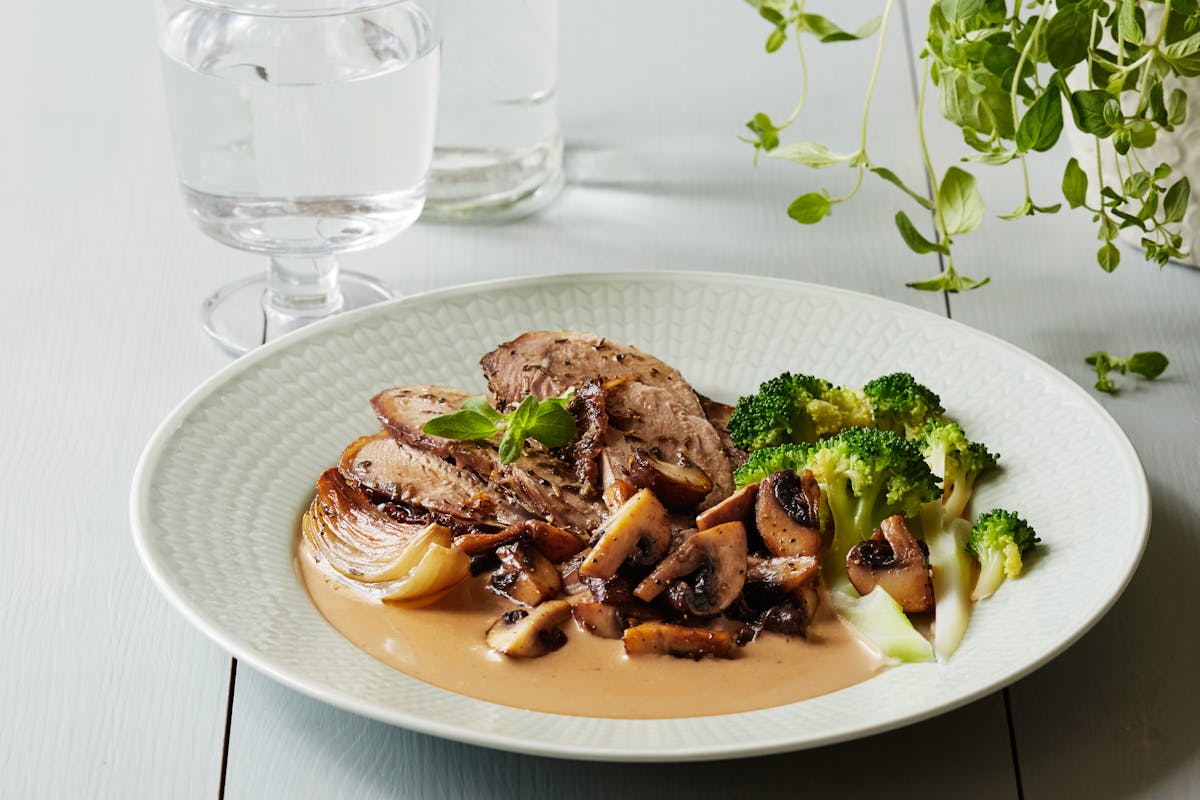

Key takeaways
Higher protein equals better results:When your diet contains enough nutritious protein you will stay satisfied for longer and maximize your weight loss and health results. More tips and ideas
Low-carb diets increase protein percentages:
Low-carb diets lead to health and weight loss success when they focus on good quality protein and the fat that naturally comes with it. Learn how
Too much fat can dilute protein:
If you are not losing weight on your low-carb diet you may be consuming too much fat. Look for ways to dial back the fat and up the protein while keeping your meals tasty and satisfying. More
1. Higher protein delivers better results for my patients
Why do I feel that prioritizing protein versus “empty energy” is so important? Because I’ve seen it over and over again: by keeping protein high, many of my patients have found they get more satiety and nutrients per calorie, they consume less unused energy that needs to be stored as fat, and they’re more apt to maximize their weight loss and health success. Research backs this up.1
I’ve been recommending low-carb diets for more than 20 years to my patients in my Seattle-based family practice. My personal story, about how I found out about low-carb diets, was told a few years ago by Diet Doctor.
Over those years I estimate I’ve had more than 100,000 patient encounters (20 patients a day x 5 days a week x 50 weeks a year x 20-plus years of practice.)
I’ve had hundreds of patients decide to adopt a low-carb way of eating. Many have had stellar results, achieving a healthy weight, much-improved lab tests, and great health even if they were very sick when they started.
At first, I put the transformation down entirely to the fact they had dramatically reduced the carbs in their diet. But after a while, I realized that when you reduce your carbs in your diet, you automatically increase the percentage of protein you are eating.
Remember, the three macronutrients are protein, fat, and carbs.
The right amount of protein is responsible for building, repairing, and maintaining body structures like muscle, bone, organ tissues, blood, hair, teeth, and nails. The right amount of fats and carbs provides energy and enables the body to run well without storing excess energy as body fat.
If your body were a car, fats and carbs would be the fuel for the car. But protein IS the car. A low-carb or keto diet that puts all the focus on the fuel, and not on what is needed for the repair and maintenance of the body as a machine, is missing part of the bigger picture.
I wrote The P:E Diet to clearly set out the relationship of protein to energy and to point out all the ways that our modern food environment clashes with our body’s needs for both.
Did you know that the only time that carbs and fat really come together in the natural world is mammalian milk, as well as nuts and seeds? These are all designed to make things grow bigger!
But in the modern food environment, carbs and fat often come together in irresistible, hyperpalatable food like donuts, cakes, pastries, French fries, potato chips, nacho chips, and more. And yes, even nuts, seeds, and some dairy products.
When you cut out carbs, you also tend to cut out the fat that comes with carbs and just leave behind the fat that comes with high-quality protein. Think: salmon, beef, eggs, chicken, and turkey. All are good sources of protein and essential fats and are naturally low in carbs.
When the only carbs you eat are vegetables that are full of nutrients, water, and fiber, you are not getting excess energy. Together with the protein and fat, you are getting everything your body needs.
With little effort or tracking, that low-carb approach turns out to be a pretty good protein-to-energy balance for many people. This leads to dramatic success for a lot of people on a low-carb diet.
But not all. Why not?
I became obsessed with figuring out what was happening with my patients who tried low-carb or keto eating but did not get good results.
2. Why do some people not fully succeed on low carb?


When I examined it closely, I began to see a common pattern: they were overeating fat and under-eating protein and nutrients.
Sure, they were now keeping their carbs very low, but they were filling up on fat bombs, buttered coffee, bacon, heavy cream, high-fat cheese and other foods that were high in fat and low in protein and nutrients.
Initially, they would lose 20 pounds or so. But then they would stall.
They would still have lots of weight to lose. They would still have unhealthy visceral [abdominal] fat and their body fat percentage would still be too high. Their lab tests and health markers like fasting blood sugar or blood pressure, while perhaps better than before, would still be outside the normal range.
The problem (and the solution) really struck me when I had a few patients who decided to do a zero-carb diet. These patients went fully carnivore and cut out carbs completely. A few who had obesity and diabetes began to eat only very fatty meat and animal products like bacon, sausage, pork shoulder, prime rib, cheese, and heavy cream.
If carbs were the only problem for obesity and diabetes then cutting out all carbs should have improved their health status. But it didn’t. Their weight got worse; their diabetes got worse.2
That’s when I realized that too much non-nutritive, empty energy, whether it is from carbs or fat, is unhealthy for anyone whose body does not use that energy up or have the place to store it.
Gradually I realized the principles at work were unbelievably simple: target nutrient density — mostly just protein and minerals — while minimizing energy that exceeds your personal carbohydrate tolerance and personal fat threshold.
3. Understanding our body’s requirement for protein & nutrients
I am not the only clinician or scientist who has recognized the primary importance of protein for human health and functioning.
In fact, in recent years it has become increasingly clear that the human body has a strict, highly regulated requirement for protein.3
Two Australian scientists, David Raubenheimer and Stephen J. Simpson, of the University of Sydney, were the first to develop what is called the protein leverage hypothesis, published in 2005. They proposed that humans will prioritize the consumption of protein and will eat until protein needs have been met.4
In our modern food environment, the energy from carbs and fat is cheap and abundant. This has led to the dilution of protein and minerals in our food supply, which has further led to protein and nutrient hunger. We literally have to eat more energy just to satisfy our nutrient needs.
If you look at a graph of obesity over the past 50 years and zoom in on the macronutrients, you can see that beginning around 1970, the calories consumed from carbs AND fat went up equally and significantly but not protein. (The fat percentage did not go up, but the absolute amount consumed in the diet did.) Absolute protein rose slightly but the average protein percentage of diets actually dropped from around 14% of calories to 12.5% in America.
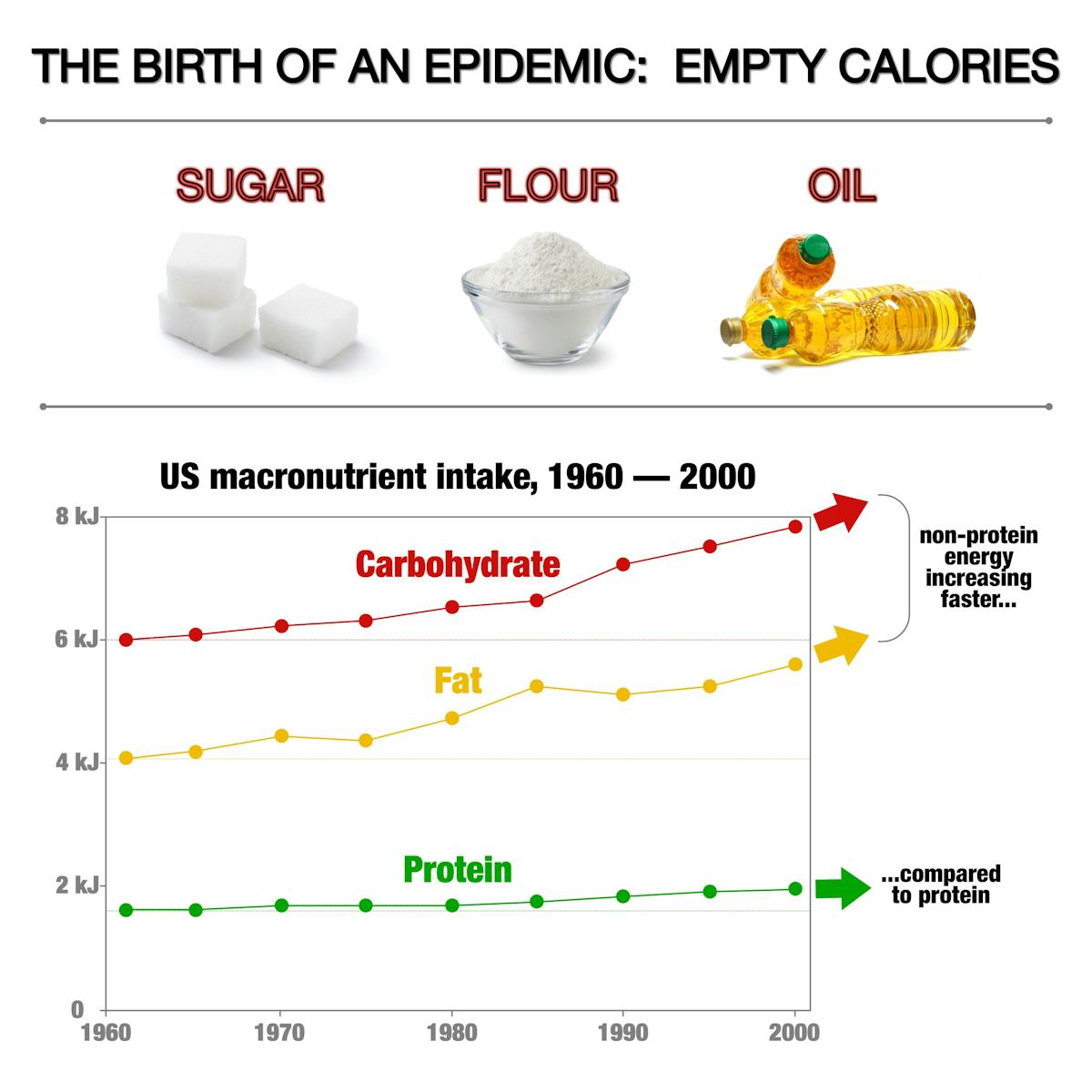

Some human feeding studies have shown that humans tightly prioritize protein, and the lower the absolute protein percentage of their food, the more energy they will eat in order to get adequate protein. The opposite is also true: the higher the protein percentage of their food, the less energy humans need to eat in order to get adequate protein.5
This is the very first — and most important — rule of the P:E diet: prioritize protein, and keep the protein percentage of your diet above 25%. If the protein percentage of your diet is high, you will tend to automatically eat less energy. And you will be more apt to lose weight and improve your metabolism.
4. Is the low-carb diet working for you? Then don’t change a thing
If you are eating a ketogenic or low-carb diet and it is working perfectly for you, you do not need to change a thing. Without much effort, by cutting carbs and processed foods, you may already be prioritizing enough protein for your body’s needs.
How do you know if you are doing great? Here are a few ways to tell:
- You are still losing weight at about an average of pound a week or you are at or near your goal weight.
- Your lab tests and health markers are steadily improving or now in normal range. This means measures like fasting blood sugar, postprandial (after meals) blood sugar and hemoglobin A1c (measure of average glucose over three months) are all either improving or normal.
- Your waist measurement is decreasing or has reached a point where it is half the size of your height or smaller (a marker that suggests you are metabolically healthy).6
- You are able to go for four or five hours without eating and no longer have “hangry” episodes where you feel you must eat immediately.
- You no longer need to snack or eat constantly and are no longer a slave to hunger. Eating when hungry and stopping when full is not a struggle.
- You are feeling energetic, mentally clear, and have more stable moods.
- You are not fighting cravings for carbs and you’ve not had periods of binge eating where you lose control of your diet.
- Your body fat percentage has been decreasing and you are happy with the progress of your body fat loss.
If you are experiencing most of these benefits, congratulations! Right now you don’t need to alter anything much about your macros or the percentage of protein, fat, or carbs in your diet. You might consider upping protein a bit, as an experiment, but you may be getting enough already.
As noted earlier, one of the reasons it may be working so well is that when you reduce your carbs, you automatically increase the protein percentage in your diet. In other words, when you eat fewer carbs, the amount of calories you are getting from carbs dramatically falls and the percentage from protein (with fat attached) goes up, making the protein less diluted in your diet.
To me, that’s the right way to do the low-carb or keto diet: reduce the empty sugar and starchy carbs and increase the protein density of your meals. Don’t worry too much about the fat that comes with protein like the skin of a chicken breast, a piece of steak, or a salmon filet.
5. Has your progress stalled?
If you are not having success with your keto or low-carb diet, it may be that you’ve simply replaced the empty calories of sugary and starchy carbs with the equally empty calories of non-nutritious fat.
Foods like fat bombs, buttered coffee, MCT oil, seed oils, pork rind snacks, and many other sources of fat are not attached to protein. These foods provide very little nutrition or satiety per calorie.7
How do you know if you might benefit from tweaking your low-carb diet to increase your protein percentage?
- You still have a lot of weight to lose, and your progress is very slow or stalled.
- You are gaining weight on your low-carb or keto diet.
- Your body fat percentage remains relatively high.8
- Your waist is still larger than half your height.
- Your lab tests or health markers are not yet in normal range and don’t seem to be improving.
- You want to build more muscle or improve your body composition.
All of these factors may mean that by gradually increasing the amount of protein you are eating and reducing excess energy from both carbs and fat, you may see more positive results.
6. How to increase your protein
Diet Doctor defines a high-protein breakfast as one that provides at least 25 grams of protein and a high-protein lunch or dinner as one that has 30 grams of protein and has a protein percentage of 25% or higher.
The protein percentage tells you how much of a food’s calories come from protein as opposed to fat and net carbs. The higher the percentage, the more protein-dense the food (and the more protein and satiety for the fewest calories, too).
Depending on your height and your goals for weight loss or for reducing body fat, you may want to eat 30 to 40 grams of protein at each meal if you are an average-sized woman and 35 to 50 grams if you are an average-sized man.
Check the Diet Doctor chart for total daily protein* intake here:
| Height | Women | Men |
|---|---|---|
| Under 5’4″ ( < 163 cm) | 90 grams | 105 grams |
| 5’4″ to 5’7″ (163 to 170 cm) | 100 grams | 110 grams |
| 5’8″ to 5’10” (171 to 178 cm) | 110 grams | 120 grams |
| 5’11” to 6’2″ (179 to 188 cm) | 120 grams | 130 grams |
| Over 6’2″ (188 cm +) | 130 grams | 140 grams |
*Recommended daily protein intake by sex and height
Diet Doctor has many resources for integrating higher protein into your diet, including guides on high-protein meats, vegetables, dairy, nuts, and snacks. There are guides for high-protein breakfasts, how to get started with high-protein eating, and how to prioritize protein across the day.
If you are just starting out eating a higher protein diet, you might want to increase your protein grams and percentage slowly to see how you feel and how your body responds, especially if you find eating more protein a challenge. Think of protein, carbs, and fat as levers. Try to slowly dial up the protein and dial down the fat while keeping carbs low.
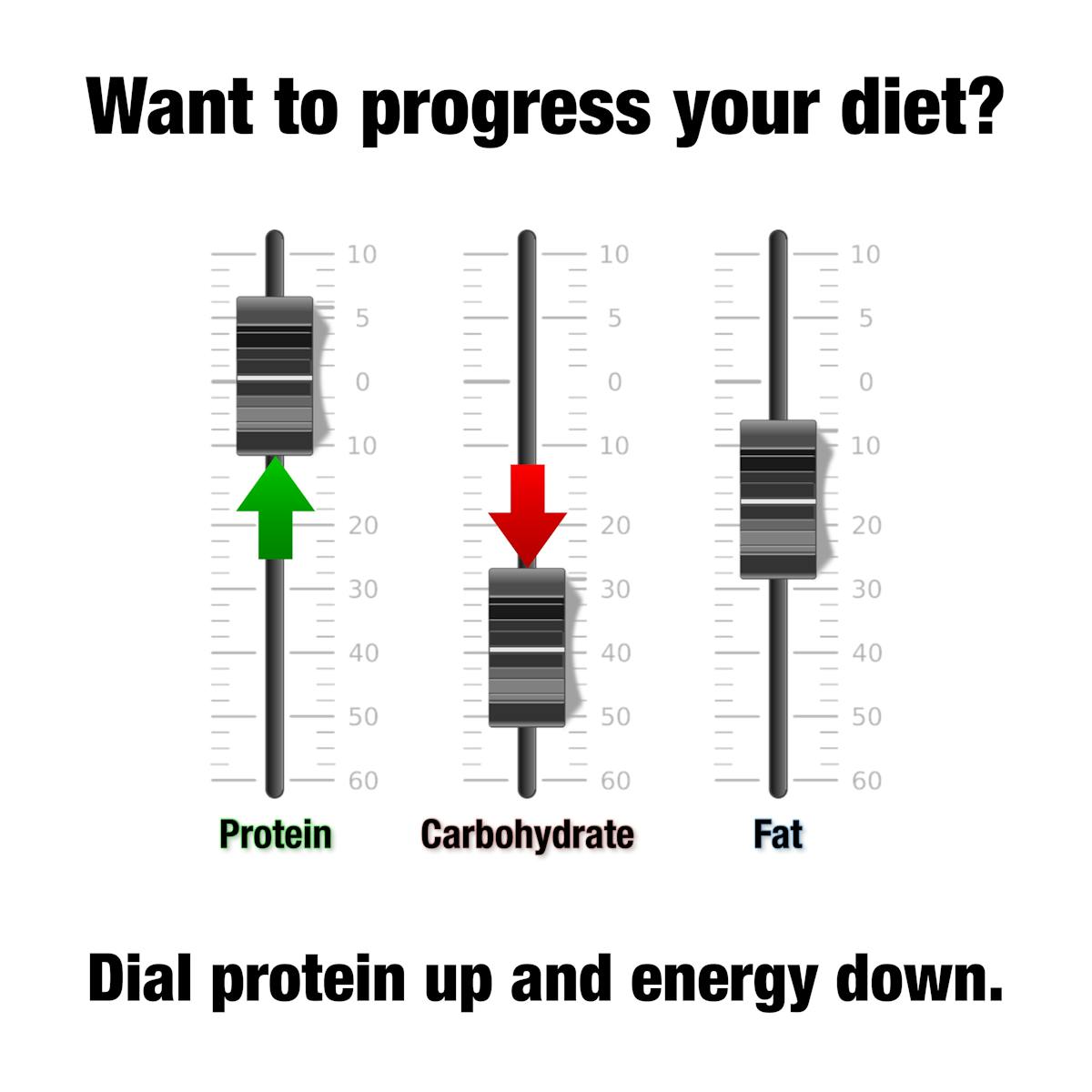

When you increase the protein, keep the fat that comes with that protein, but try not to add much extra fat beyond what you need for taste. Other tips:
- Prioritize protein in your first meal of the day.
- Center your meals around a good source of protein and then add high-fiber vegetables.
- Consider swapping bacon for leaner back bacon (also called Canadian bacon), ham, or turkey bacon.
- Keep the skin on chicken breast or turkey, but reduce fat in other places like cutting down on sour cream, butter, mayonnaise, or oils.
- Consider using lower fat Greek yogurt. Read the label to ensure it does not have extra starch, sweeteners, or fillers.
- Reduce your consumption of low-protein, high-fat foods like cheese and nuts.
- When possible select grass-fed and leaner ground beef.
We know that people following a keto diet can become confused or even feel betrayed if, in order to increase the protein percentage, we suggest you consider a low-fat food (such as lower fat dairy or ground beef) in order to get a higher protein percentage.
Isn’t low-fat the enemy?
The answer to that question is nuanced. Yes, highly processed low-fat products should be avoided if the food is one where fat has been replaced with sugar, fillers, or sweeteners like maltodextrin to make it taste more palatable.
But some low-fat dairy products have a higher protein percentage and no extra sugar or fillers. They can increase your protein percentage without increasing calories. Read the labels to be sure.
Additionally, it helps to differentiate adding low-fat products into your low-carb diet from eating a completely low-fat diet. Low-fat diets have failed many people, but that does not mean you can’t benefit from adding a few low-fat foods into an otherwise healthy low-carb diet.
Use these tips to customize your diet to the low-carb foods you like best. If you can’t imagine your morning eggs without bacon, look for other places to dial back the fat instead.
If you like full-fat yogurt best, there is no need to stop eating it. It’s a great source of protein. Just look for other sources of extra fat in your diet that you are happy to reduce if you want to lose more weight.
Check out the Diet Doctor resources for more high-protein tips, recipes, and meal plans.
Related content
7. What about the carbs?
If you are focusing on the protein percentage of your diet, do you have to be so strict about eating low carb?
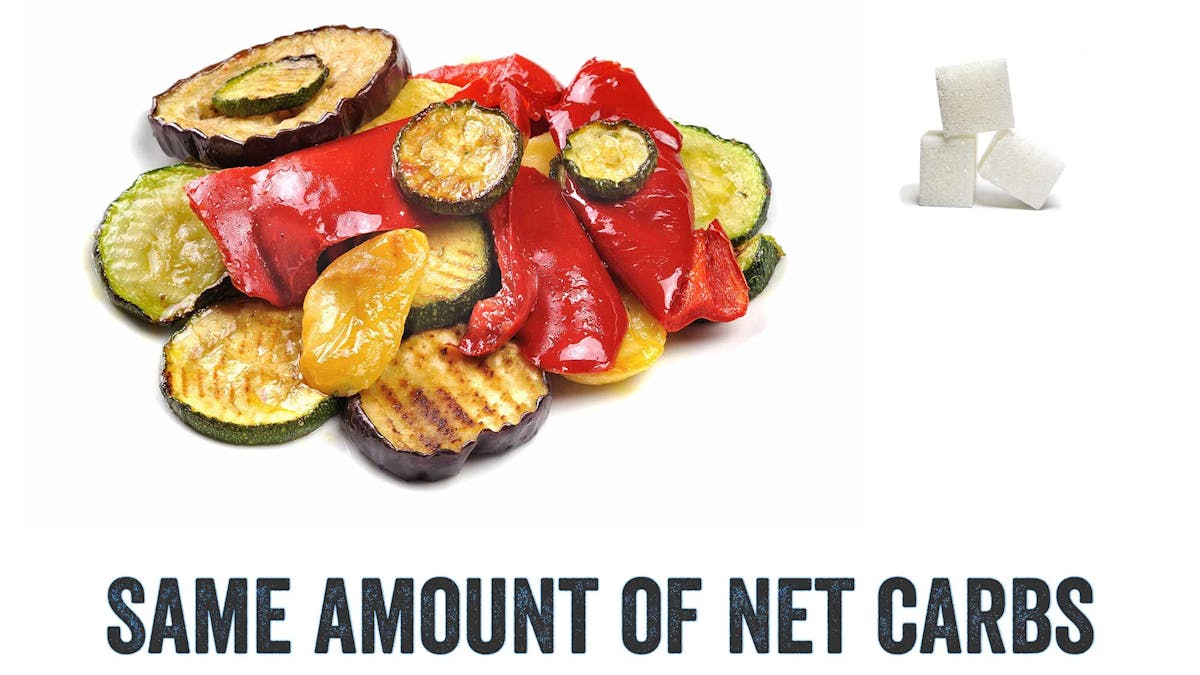

The short answer is: it depends. It is completely up to you, your personal carb tolerance, your food likes and dislikes, and your health status.
A higher protein percentage can make some people more metabolically flexible, enabling them to eat a moderate or liberal low-carb diet that includes nutritious carbs with low energy density. This can make the low-carb diet more sustainable for them over the long-term while still getting excellent health results in the form of weight, body fat, and blood sugar control.
But note, this does not mean suddenly eating bread, pasta, rice and other highly processed carbs again. Rather, it is eating whole-food carbs like low-sugar fruit, sweet potato, beans, carrots, squash, and other nutritious, high-fiber fruit and vegetables.
I know that by discussing adding back in carbs, some avid low-carbers get very nervous or even upset. Cutting carbs has worked for you. Again, if very low carb is working for you, you do not need to change anything.
However, if you want to try upping your carb intake, add vegetable or fruit carbs back in slowly and see how you do. If it spurs cravings or causes you to lose control of your diet, go back to stricter keto or low-carb foods.
If you have had diabetes or blood sugar problems, check your blood sugar regularly to ensure your blood sugar is not rising. If it is, go back to a stricter low-carb or keto approach. You are in charge of making your diet the most enjoyable and successful for you. Diet Doctor’s role is to give you evidence-based information to help you do that. That is what empowerment means and Diet Doctor’s mission is to empower you to improve your health.
8. Why you might want to add back a few carbs
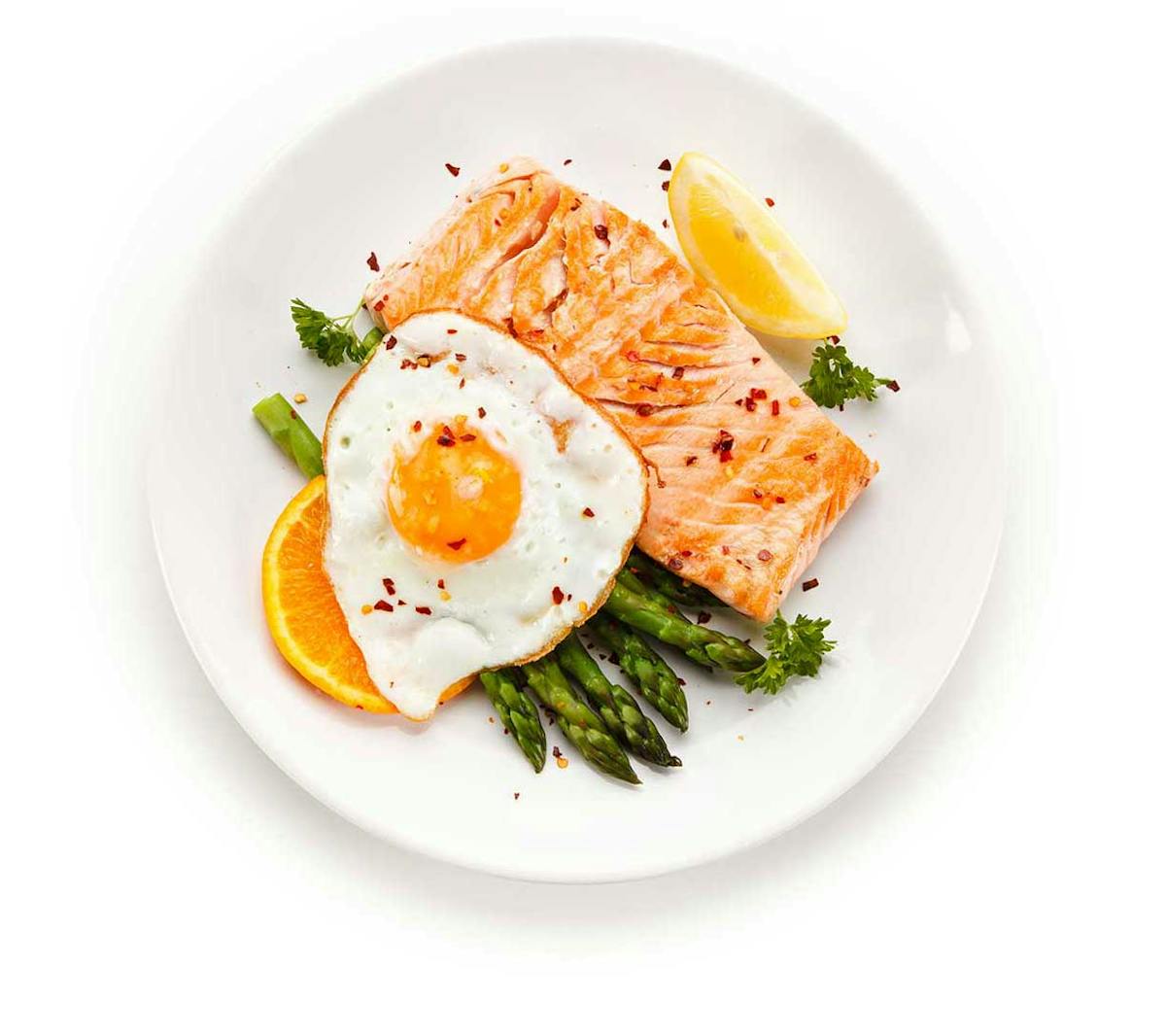

We can’t say it too often: if you are doing well on your low-carb or keto diet you do not have to add back more carbs!
However, it is my clinical experience that there are some reasons why you might want to consider including some carbs in your diet.
The biggest one for me is the potential to improve your sleep quality.
Some patients complain of having a harder time falling asleep or staying asleep when they do a very strict low-carb or keto diet. People describe feeling “revved up” and more wakeful.
It makes sense from an evolutionary perspective to be more alert, active, and energetic when you have the highest need to look for food. And this response may be why some people describe feeling more mentally alert and energetic on a very low-carb diet.
But some research as well as my clinical experience has found that some people experience sleep disturbances when eating a very low-carb diet.9 Timing carbs in the evening could provide a few benefits such as faster sleep onset.10
If you have difficulty sleeping on a very low-carbohydrate diet, you could eat a few more carbs at your evening meal. The amount could be about 20 grams, such as from sweet potato, squash, a few more vegetables, or some pieces of apple or other fruit.
Not only could your sleep benefit, but it could leave you feeling more alert during the day, when your glycogen is low after your overnight fast.
Additionally, by eating carbs in the evening rather than at breakfast, you are possibly less likely to be affected by the downstream hunger that can occur three to four hours after eating carbohydrates.
Carbs are unique in that they offer an initial satiety for a few hours, followed by an increase in hunger as blood sugar falls.11
So be very judicious about your use of carbs.
Choose carbs with the very lowest energy density. In other words, pick foods with as much water, fiber, and protein as possible. These foods will provide the highest satiety for the lowest carbohydrate content. Check out Diet Doctor’s top high-protein vegetables guide.
9. Summary
If you are happy with your weight loss and health results on your current keto or low-carb diet, stay the course. You are likely getting enough protein and not too much excess energy.
But if your weight loss is stalled, or even increasing, or your health markers are not yet normal, increasing your protein percentage in your meals, while reducing carbs and fat, may bring about better results.
Keep the fat that comes with protein, but avoid deliberately adding too much excess fat to your meals or drinks. Feel free to use a small amount of fat for cooking or for flavor. You don’t need to eat your broccoli or spinach dry, without butter or a cheese sauce. Use fat to make your food taste good so that you enjoy it. But if you are stalling in your progress, see if you can reduce it just a little bit in places you won’t miss it.
When you increase your protein percentage, you may also become more metabolically flexible and be able to add back in some nutritious carbs, if desired. Doing so in the evening may improve your sleep. Choose carbs with the lowest energy density, which means the ones with as much water, fiber, and protein as possible.
Remember, in order to be successful over the long term, your diet has to be enjoyable and sustainable. Learning how to adjust your diet for the best personal results will truly empower you for life.
The secret is finding a way to target and prioritize protein, while still eating foods you enjoy. Diet Doctor is here to help.
Do you want more information about protein-to-energy ratios? If you become a Diet Doctor member, you can get my book at a significant discount. Just follow the links below to become a member then come back to the bottom of this guide to receive the special discount code.Our top high-protein recipes
Systematic reviews of randomized controlled trials — considered the strongest type of evidence — show that higher protein diets tend to help people lose weight, maintain a higher metabolic rate, and prevent muscle loss:
Journal of the American College of Nutrition 2004: The effects of high protein diets on thermogenesis, satiety and weight loss: a critical review [systematic review of randomized trials; strong evidence]
Nutrition Reviews 2016: Effects of dietary protein intake on body composition changes after weight loss in older adults: a systematic review and meta-analysis [strong evidence]
The American Journal of Clinical Nutrition 2012: Effects of energy-restricted high-protein, low-fat compared with standard-protein, low-fat diets: a meta-analysis of randomized controlled trials [strong evidence]
Nutrition Reviews 2016: Effects of dietary protein intake on body composition changes after weight loss in older adults: a systematic review and meta-analysis [strong evidence] ↩
We don’t deny the clinical and personal experience that many people can improve multiple aspects of their health with a zero carb diet. But in my experience, I have seen many people’s metabolic health worsen as well. ↩
Studies of 116 diets in humans suggest that people on average eat nearly three times more calories on a low-protein diet than on a high-protein diet:
Annual Review of Nutrition 2016: Nutritional ecology and human health [overview article; ungraded] ↩
Obesity Reviews 2005: Obesity: the protein leverage hypothesis [overview article; ungraded]
PLoS One 2011:
Testing protein leverage in lean humans: a randomised controlled experimental study[randomized trial; moderate evidence]
↩PLoS One 2011: Testing protein leverage in lean humans: a randomised controlled experimental study[randomized trial; moderate evidence]
Annual Review of Nutrition 2016: Nutritional ecology and human health [overview article; ungraded]
Nutrition Reviews 2016: Effects of dietary protein intake on body composition changes after weight loss in older adults: a systematic review and meta-analysis [systematic review of randomized trials; strong evidence]
American Journal of Clinical Nutrition 2008: Protein, weight management, and satiety [overview article; ungraded]
Journal of the American Dietetic Association 2005: Perceived hunger is lower and weight loss is greater in overweight premenopausal women consuming a low-carbohydrate/high-protein vs high-carbohydrate/low-fat diet [randomized controlled trial; moderate evidence] ↩
Obesity Reviews 2014: Waist-to-height ratio is a better screening tool than waist circumference and BMI for adult cardiometabolic risk factors: systematic review and meta-analysis [strong evidence] ↩
Many people find fat very satiating. Simply adding more fat can help people dramatically reduce their hunger. I am not saying that fat isn’t satiating, but I am pointing out that it can take a lot of calories to provide its satiating effect, whereas protein can do so with many fewer calories. That’s why I like to talk about satiety per calorie. ↩
While healthy body fat percentages are a range and vary with age, you might benefit from losing a bit more body fat if your body fat is higher than 28% (for women) or above 15% (for men)
American Journal of Clinical Nutrition 2012: Percentage of body fat cutoffs by sex, age, and race-ethnicity in the US adult population from NHANES 1999-2004 [non-controlled study; weak evidence] ↩
The following study reported a nonsignificant trend toward “insomnia,” or worsening sleep performance. Although the finding did not reach statistical significance, it is clear that some individuals experienced this change, which matches my clinical experience.
Obesity 2012: The effects of a low-carbohydrate ketogenic diet and a low-fat diet on mood, hunger, and other self-reported symptoms [randomized controlled trial; moderate evidence] ↩
This is based on my clinical experience and that of many other practitioners familiar with low-carb nutrition. It is also supported by a few studies, but more research is needed. [weak evidence]
Nutrition Research 2021:Diet promotes sleep duration and quality [overview article; ungraded]
Nutrients 2021: A systematic review, meta-analysis and meta-regression on the effects of carbohydrates on sleep [systematic review of randomized trials; strong evidence] ↩
This is based on the consistent clinical experience of practitioners familiar with low-carb nutrition. [weak evidence]
And preliminary research supports this theory as well.
Nature Metabolism 2021: Postprandial glycaemic dips predict appetite and energy intake in healthy individuals[non-controlled study; weak evidence]
↩



